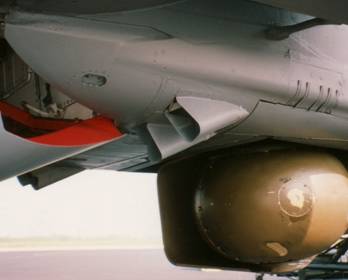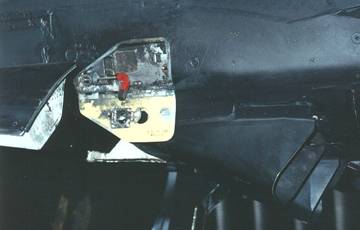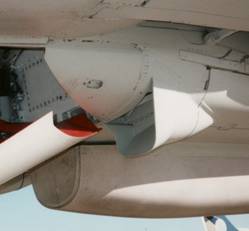F-111 Weapons Bay
By Jim Rotramel
|
 |
|
The weapon bay M61 gun
installation is illustrated by this views, and the first image in the text
below. Note the bomb rack at top left of the top photo and the shape of
the fairing in the bottom photo along with the white rotating muzzle
cover. |

HyperScale is proudly supported by Squadron
The second worst blunder in the
Minicraft 1/48 scale F-111 kit is the weapons bay, and again, while Scaledown
has this on their list of things to do, it has not yet been accomplished. There
were five types of interchangeable F-111 weapon-bay doors:
Normally, the real weapons bay
doors were ALWAYS opened after the airplane taxied to its parking spot and not
closed until after the engines were started. These doors are what the Minicraft
kit purports to represent. The problem is that they are modeled in the closed
position and split laterally through the middle of the doors, which makes
modeling the aircraft as it was normally seen on the ground almost impossible.
(It’s also worth noting that the same problem exists with the Hasegawa 1/72nd
scale kits, as they also model the weapon bay doors only in the closed position.
The only times this didn’t happen was if the WSO forgot to follow his checklist,
an ECM pod was fitted in the forward position, or during the Cold War when Varks
sat nuclear alert and no weapons were being carried in the weapons bay. These
doors were used with an internal luggage rack, nuclear weapons, and/or ‘Tokyo’
fuel tanks.
An M61A1 20-mm gun was optional
equipment for F-111A/D/E and pre-Pave Tack F-111C/F models (the FB-111A/F-111Gs
never used gun). The gun installation replaced the two bay doors on the right
side of the aircraft and extended just slightly over the centerline. Unless the
gun system was selected, a fairing rotated to cover the end of the gun barrels.
The gun was installed on all aircraft used in Vietnam, but never used. The guns
were removed about 1983 when AIM-9P-4s began to be carried for self-defense. On
stateside-based F-111As and F-111Ds, the guns were often still carried, but
seldom used. The European-based F-111Es and non-Pave Tack F-111Fs reverted only
to the original weapon bay doors.

Pave Tack pods were mounted on a
rotating cradle in the weapons bay, thereby minimizing the pod’s impact on
aircraft performance. For this, the outer weapons bay doors were modified with a
‘cut out’ section towards the rear, while the inner ones were replaced by the
cradle. The doors were left open while on the ground, but closed prior to taxi.
They were not normally opened in flight. Looking forward, the cradle rotated
clockwise to stow the pod and counterclockwise to expose it. The pod was stowed
prior to takeoff, and usually kept that way for most of the mission until
nearing the target area, when it was used by the WSO to find and designate
targets for LGBs. It was extended prior to landing, with the turret tucked away
in the ‘stowed’ position to protect the forward-looking infrared (FLIR)
window. (This window was a milky amber color, while the two smaller laser
windows were clear, but had a distinct bluish tint.)
The cradle was a metal frame
covered with a thin, aerodynamically shaped fiberglass fairing. To allow
uninhibited movement of the pod head, there was a ‘box’ cut out of the rear of
the cradle on the pod side. The pod head rotated about the longitudinal axis of
the barrel, while the turret rotated at right angles to the head. This
wrist-like movement allowed the pod to view virtually the entire hemisphere
beneath the aircraft. The four-inch ‘hump’ exposed when the pod was stowed in
the weapons bay was smoothly faired, with no ‘hard’ lines. Two sets of bolt
holes with 30-inch spacing were visible on the ‘hump’ side of the cradle and
used to mount the pod to it. The pod was overall 34087 olive drab with
predominately black markings, while the cradle was painted to match the
aircraft’s paint scheme.
Between 1981 and 1984 all
F-111Fs were modified to carry the Pave Tack pod; Australian
F-111Cs were also modified beginning in the late 1980s. Although usually
installed, the cradle could be replaced by the normal weapons bay doors in about
an hour.
|

|
| This
photo shows how the Pave Tack pod normally looked on the ground, with the
weapon bay doors open and its head rotated into the “stowed” position with
the window rotated into the protective fairing. Also note the yellow
cooling duct and its white fitting. The duct was only on the right side of
the weapon bay. In flight, the bomb bay doors remained closed while the
pod rotated in and out of the weapon bay on its cradle. |
|

|
|
This photo shows an extended
Pave Tack pod as displayed at an air show, which is about the only time
one would intentionally leave the weapon-bay doors closed. More
importantly, it clearly shows the prominent bomb bay hinge fairing shared
by all models. |


The
Pave Tack pod head is shown in the left photo (above). Note the orange IIR and
two smaller, clear laser windows. The large gear mechanism was only located on
the right side of the head. The right photo shows the four air-water heat
exchanger vents that were exclusive to F-111D/Fs. Also, note the weapon bay
hinge fairing and the inlet brace at top right.


The
left photo (above) shows the small door for the weapon-bay safety pin, located
just behind the doors on the left side of the aircraft, was always open on the
ground. EF-111As (right) had a single, large air water heat exchanger vent on
each side of the fuselage.
The EF-111A had a special
cradle hinged on the right side of the fuselage to hold its AN/ALQ-99 jamming
system. EF-111As and RF-111Cs only opened their bays for maintenance.
The RF-111C reconnaissance
pallet had a special cradle hinged on the right side of the fuselage that was as
wide as three of the four weapon bay doors, leaving the left-most door in its
original configuration, except for the addition of a single camera window.
Text Copyright © 2002
Jim Rotramel
Images Copyright © 2002 United States
Department of Defense and Jim Rotramel
Page Created 09 March, 2002
Last Updated
15 December, 2003
Back to Reference Library
|
Home |
What's New |
Features |
Gallery |
Reviews |
Reference |
Forum |
Search